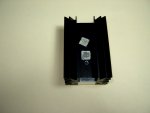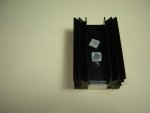- Joined
- Sep 20, 2008
- Messages
- 17,644
- Points
- 113
We've been working on a new High Power Thermopile
Sensor coating capable of read to 12 watts for a new
LaserBee LPM product...
Today we started the final tests and as we ramped up
the adjustable 40 Watt Laser to near 12 watts the LPM
reading started to slowly drop and at 8 watts dropped
right down to zero... I was sure it was the Laser.
Tuning down the Laser and checking the output with
our Newport LPM the Laser was just fine.
Under close examination of the new TEC that was sealed
with silicone on the edges it seems the solder used to
hold the top plate to the bottom plate by the PN junctions
came unsoldered....
In 10 years of working with these TECs I've only seen this
happen one time before 11 years ago when we tried to bake
a coating onto a TEC at 350 Deg F for 20 minutes. The TEC
obviously fell apart into many pieces.
This now has me wondering about small TECs subjected to
High Laser power for extended periods. If only part of the
PN juctions are damaged and it is not a catastrophic failure
like mine.... is the TEC still calibrated to the LPM...:undecided:
Pics are attached below...
Jerry
Sensor coating capable of read to 12 watts for a new
LaserBee LPM product...
Today we started the final tests and as we ramped up
the adjustable 40 Watt Laser to near 12 watts the LPM
reading started to slowly drop and at 8 watts dropped
right down to zero... I was sure it was the Laser.
Tuning down the Laser and checking the output with
our Newport LPM the Laser was just fine.
Under close examination of the new TEC that was sealed
with silicone on the edges it seems the solder used to
hold the top plate to the bottom plate by the PN junctions
came unsoldered....
In 10 years of working with these TECs I've only seen this
happen one time before 11 years ago when we tried to bake
a coating onto a TEC at 350 Deg F for 20 minutes. The TEC
obviously fell apart into many pieces.
This now has me wondering about small TECs subjected to
High Laser power for extended periods. If only part of the
PN juctions are damaged and it is not a catastrophic failure
like mine.... is the TEC still calibrated to the LPM...:undecided:
Pics are attached below...
Jerry





